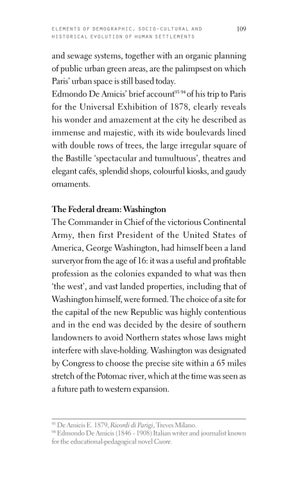elements of demographic, socio-cultural and historical evolution of human settlements
109
and sewage systems, together with an organic planning of public urban green areas, are the palimpsest on which Paris’ urban space is still based today. Edmondo De Amicis’ brief account93 94 of his trip to Paris for the Universal Exhibition of 1878, clearly reveals his wonder and amazement at the city he described as immense and majestic, with its wide boulevards lined with double rows of trees, the large irregular square of the Bastille ‘spectacular and tumultuous’, theatres and elegant cafés, splendid shops, colourful kiosks, and gaudy ornaments. The Federal dream: Washington The Commander in Chief of the victorious Continental Army, then first President of the United States of America, George Washington, had himself been a land surveryor from the age of 16: it was a useful and profitable profession as the colonies expanded to what was then ‘the west’, and vast landed properties, including that of Washington himself, were formed. The choice of a site for the capital of the new Republic was highly contentious and in the end was decided by the desire of southern landowners to avoid Northern states whose laws might interfere with slave-holding. Washington was designated by Congress to choose the precise site within a 65 miles stretch of the Potomac river, which at the time was seen as a future path to western expansion.
De Amicis E. 1879, Ricordi di Parigi, Treves Milano. Edmondo De Amicis (1846 - 1908) Italian writer and journalist known for the educational-pedagogical novel Cuore.
93 94
